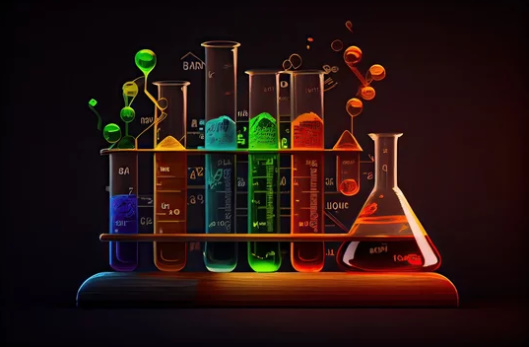Inorganic Chemistry
What is Inorganic Chemistry?
The word organic refers to the compounds which contain carbon atoms in it. So the branch of chemistry that deals with the study of compounds, which does not consist of carbon-hydrogen atoms in it, is called ‘Inorganic Chemistry.’
In simple words, it is opposite to that of Organic Chemistry. The substances which do not have carbon-hydrogen bonding are metals, salts, chemical substances, etc.
On this planet, there are known to exist about 100,000 Inorganic compounds. Inorganic chemistry studies the behaviour of these compounds along with their properties, their physical and chemical characteristics too. The elements of the periodic table except for carbon and hydrogen, come in the lists of Inorganic compounds.
Many of the elements are technologically important: titanium, iron, nickel and copper, for example, are used structurally and electrically. Second, the transition metals form several useful alloys, with each other and with other metallic elements.
Meaning of Chemistry
Chemistry is the study of the substances of which matter is composed. Chemistry is heavily experimental because you can only study reductions if you totally mix substances together. Luckily, you don’t need to risk your health and safety to understand chemistry better because brave scientists already did. There are over a hundred elements that make up the matter of our world and universe. They combine to make thousands and thousands of compounds.
A chemical compound is made up of atoms of different elements joined together by a chemical bond. The bonds are so strong that the compound acts as if it were a single substance. The joined atoms form molecules and the molecules connect together to make the compound.
A chemical formula is a notation used by scientists to show the number and type of atoms present in a molecule using atomic symbols and numeric subscriptions. A chemical formula is a simple representation, in writing, of a three-dimensional molecule that exists. A chemical formula describes a substance, down to the exact atoms that make it up. There are three basic types of chemical formula, the empirical formula, the molecular formula and the structural formula.
Chapters under Inorganic Chemistry
(a) Organometallic Chemistry
Organometallic Chemistry, a dynamic field within Inorganic Chemistry, has experienced remarkable growth over the past three to four decades. This interdisciplinary science has significantly contributed to our understanding of chemical bonding, particularly in elucidating the nature of bonds within a diverse array of organometallic compounds.
Beyond its academic significance, organometallic compounds play a pivotal role as homogeneous catalysis agents across various industries. The insights provided in this book cover a spectrum of topics, offering readers fresh perspectives and advancements in the realm of organometallic chemistry.
This branch of chemistry delves into the study of compounds containing metal-carbon bonds, distinguishing them from chemically similar compounds lacking such bonds. Additionally, organometallic chemistry encompasses compounds featuring predominantly covalent metallic bonds, further blurring the lines between traditional inorganic and organic chemistry realms.
(b) Transition Elements
A transition element is typically characterized by the presence of partially filled d-orbitals in its penultimate shell. This conceptual definition proves valuable as it allows for the identification of transition elements based on their electronic configurations alone. However, it’s worth noting that this definition excludes zinc, cadmium, and mercury, as they lack partially filled d-orbitals. Despite this, they are still regarded as transition elements due to their properties, which extend from those of traditional transition elements in inorganic chemistry. In fact, the zinc group acts as a crucial link between transition elements and representative elements.
The 24 elements classified under this definition share notable characteristics: they are predominantly metals, typically hard, solid, and lustrous, with high melting and boiling points, and exhibit good conductivity of heat and electricity. While there exists considerable variation within these properties, they collectively align with the general characteristics observed across all elements.
(c) Coordination Chemistry
The application of coordination compounds predates the formal establishment of inorganic chemistry. The systematic exploration of their structure and bonding commenced with the pioneering work of Tassaert, which was further advanced by eminent chemists such as Wilhelm Blomstrand, Jorgensen, and Alfred Werner throughout the latter half of the nineteenth century. Ultimately, Werner’s coordination theory emerged as the cornerstone of modern coordination chemistry, shaping its trajectory and providing a comprehensive framework for understanding these complex compounds.
(d) P-Block Elements
Elements ranging from group 13 to group 18 on the periodic table collectively form the p-block. In inorganic chemistry, the properties of these p-block elements, like those of elements from other blocks, are heavily dictated by factors such as atomic size, ionization enthalpy, electron gain enthalpy, and electronegativity.
A distinguishing feature influencing the properties of these elements is the absence of d-orbitals in the second period, contrasted with the presence of d- or f-orbitals in heavier elements. This discrepancy significantly impacts the characteristics of the elements, leading to notable distinctions between the properties of heavier p-block elements and their lighter counterparts.
Classification of Inorganic Compounds
Inorganic compounds can be classified into several categories:
- Acids: These compounds dissolve in water to produce hydrogen ions (H⁺). Examples include hydrochloric acid, citric acid, sulfuric acid, and vinegar. An example of an acidic reaction is:
Hydrochloric acid + water → H⁺ + Cl⁻ - Bases: Bases are substances that produce hydroxide ions (OH⁻) when dissolved in water. Examples include potassium hydroxide, calcium hydroxide, ammonia, and sodium hydroxide. An example reaction is:
Potassium Hydroxide + H₂O → K⁺ + OH⁻ - Salts: Salts are compounds formed from the reaction between an acid and a base. Common examples include sodium chloride (table salt), which is formed from the reaction of sodium hydroxide and hydrochloric acid.
- Oxides: These compounds contain oxygen atoms. They can be simple oxides composed of just one oxygen atom or more complex oxides containing multiple oxygen atoms.
Types of Reactions and Examples of Inorganic compounds
In inorganic chemistry, there are four main types of chemical reactions:
- Combination Reactions: In a combination reaction, two or more substances combine to form a single product. For example:
Barium + F₂ → BaF₂ - Decomposition Reactions: In a decomposition reaction, a single compound breaks down or decomposes into two or more products. For example:
FeS → Fe + S - Single Displacement Reactions: In a single displacement reaction, one element replaces another element in a compound, resulting in the formation of a new compound and a free element. For example:
Zn (s) + CuSO₄ (aq) → Cu (s) + ZnSO₄ (aq) - Double Displacement Reactions: Also known as metathesis reactions, double displacement reactions involve the exchange of ions between two compounds, resulting in the formation of two new compounds. For example:
CaCl₂ (aq) + 2AgNO₃ (aq) → Ca(NO₃)₂ (aq) + 2AgCl (s)
Applications of Inorganic Chemistry
Inorganic chemistry boasts a multitude of applications across diverse fields such as biology, chemistry, engineering, and beyond:
- Medicine and Healthcare: Inorganic chemistry plays a crucial role in medicine and healthcare, contributing to the development of pharmaceuticals, diagnostic agents, and medical imaging technologies.
- Everyday Life: Common inorganic compounds like sodium hydroxide (common salt) find widespread use in everyday applications, from cleaning agents to food processing.
- Food Industry: Inorganic compounds such as baking soda are essential ingredients in the preparation of various food items, including cakes and other baked goods.
- Ceramic Industries: Inorganic chemistry is instrumental in the production of ceramics, which are used in diverse applications ranging from household ceramics to advanced materials for aerospace and electronics.
- Electronics and Electrical Engineering: Inorganic compounds like silicon are fundamental components of electronic devices and circuits, including computer chips, solar cells, and semiconductor devices, driving advancements in technology and innovation.


Thanks for sharing Samuel… Very helpful.